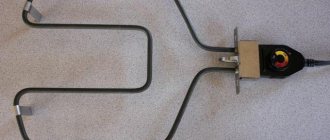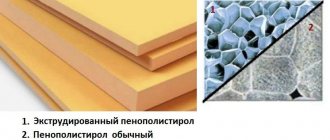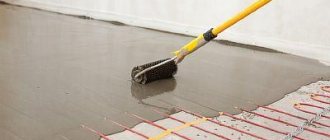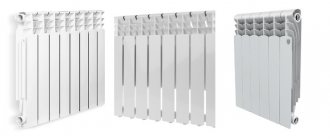What are ceramic infrared heaters?
A ceramic heater is a new word in creating energy-efficient heating systems without laying pipes and other complex manipulations. It can be used independently or in combination with other heat sources: wood stoves and fireplaces, thermal curtains, convectors. As a rule, the power of such devices does not exceed 1000 W.
The main feature of ceramic heaters is the gradual release of heat. It flows evenly without drying out the air flow. Ceramics are environmentally friendly and natural, do not emit hazardous substances into the atmosphere, and are hypoallergenic. Such heaters have a wide variety of designs; there are differences even in the method of heat generation. For example, ceramic wall panels do not distribute heat by convection, but transfer it to objects around them.
Why is it needed and where is it used?
Heating equipment is needed everywhere:
- Houses,
- At work,
- in the country,
- in the garage
- In workshop.
Devices operating on the principle of infrared radiation can also be used outdoors:
- to create comfortable thermal zones in summer cafes, pavilions, and recreation areas;
- heating terraces and verandas;
- creating a thermal curtain in the entrance areas of public institutions, shopping complexes, and places with high traffic;
- in greenhouses and greenhouses.
How it works: device principle of operation and pros and cons
Infrared heaters are fundamentally different from convector-type heating devices: they heat not the air, but the surfaces of objects. Those, in turn, begin to radiate heat into the space around them. In this way, a microclimate that is comfortable for humans is formed.
Moreover, it is limited not by the walls of the room and other obstacles that retain warm air, but by the zone of influence of infrared radiation. It stably maintains the temperature set by the user. This provides local heating.
This capability of infrared devices is often used when performing work in unheated garages and construction sites.
The latter are autonomous, the housing provides space for installing a container with fuel (gas cylinder), a burner, and has a protective grille.
But the operating principle of both types of devices is the same and is ensured by several mandatory design elements:
- heating element;
- emitter;
- reflector;
- a layer of thermal insulation;
- thermostat (thermostat).
The operating principle is as follows:
- by supplying power or burning gas fuel, the heating element is heated;
- it, in turn, transfers heat to the emitter;
- radiation of infrared zones begins in the range determined by the material of this structural element (emitter);
- waves pass freely through the air and are reflected from objects encountered along the way;
- at the same time, they penetrate to a certain depth of the surfaces of obstacles, causing activation of the movement of molecules with a corresponding release of heat.
Objects located in the infrared zone heat up and transfer part of the thermal energy to the air. The latest generation of IR heaters are equipped with a heating element made using MAO (micro-arc oxidation) technology. These devices are characterized by a long service life (at least a quarter of a century) and high heating efficiency.
pros
Fire safety of electric models and multi-level protection against ignition of gas appliances.
Low heating of the metal body, which eliminates the risk of unpleasant sensations and burns when touched.
Modern design.
Convenient controls.
High-quality local heating of poorly insulated rooms and outdoor spaces.
Two or more power modes.
Possibility of floor, wall and ceiling installation.
Minuses
Slower heating of rooms than when using convector-type devices.
The need to maintain the distance recommended by the manufacturer from the place of installation of the heater to household and electronic appliances, furniture.
Device types
All existing ceramic heaters can be divided into several categories. The main distribution concerns the power source used. This can be done by liquefied gas or electric current.
- Gas appliances. Not every owner of a country house knows that gas energy-saving heaters exist. Meanwhile, today they are widely used for heating non-electrified dachas and country cottages with weak network throughput. The heating temperature in such devices reaches 900 degrees Celsius, they are more powerful, and can easily and quickly create a comfortable atmosphere in the room.
- Electric heaters. The most common option is ceramic infrared heaters, which combine two types of thermal radiation. Initially, ceramics were used here as a coating for spirals; a model with a thermostat made it possible to determine the intensity of heat supply. Today, inside the body of such a device there are ceramic panels, onto which the heating is directed. The ability of such heat exchangers to retain heat for a long time is complemented by convection - a fan. As a result, the distribution of the heat wave is more uniform and gradual.
- Ceramic panels, IR heaters. Inside the product there is a base - a housing with a polymer coating, on which an electric heating cable is spirally located. A ceramic panel is located on top, ensuring a gradual and effective distribution of the generated heat. Since the fastening to the wall is not carried out tightly, there is an intense exchange of warm and cold air flows.
Reasons for growing popularity
The popularity of ceramic heating batteries is growing because they are superior to traditional radiators in many consumer characteristics.
- A ceramic heater heats the room completely or partially, for example, near a desk or a crib.
- Drafts do not form due to the absence of intense movements of air masses with different temperatures.
- The batteries consume electricity sparingly and are equipped with electronic thermostats that control the temperature in the room. When heated above the set temperature, the automation turns off the electrical power.
- Battery efficiency is above 90 percent. Electricity is completely spent on heating.
- The ceramic device does not dry out the air.
- Can be used to heat rooms with high humidity.
- The electric heating element is located inside the housing, accidental contact is impossible.
- The outer part does not heat up to a temperature that can burn the skin; the device can be used to heat children's rooms.
- The batteries are made from environmentally friendly materials.
- The heater operates silently.
- Maintenance is easy - just wipe the dust off the surface with a cloth.
- Installation is not difficult. The kit includes the necessary mounting parts.
Device, principle of operation
Placement method
All ceramic heaters are divided according to one more important indicator. The placement method determines the comfort in using the equipment.
There are several options:
- Floor. May appear as a column or cylinder, a rectangular block mounted on an electrically powered turntable. The system is equipped with convection; the power of such heaters varies in the range of up to 2000 W. Gas models are produced mainly in floor-standing versions, have a durable, heat-resistant body, and a handle for transportation.
- Wall. In the classic version, it looks like an air conditioner or a thermal curtain, but is mounted at the bottom of the walls. The warm air rising due to convection is evenly distributed in the room. Ceramic panels are also produced, placed by analogy with conventional radiators, on the walls under windows or in any other places. They have a large heat transfer area and are equipped with remote thermostats.
- Ceiling. This heater looks the same as a wall panel, is mounted on the ceiling, and can be electric or gas. Thanks to infrared radiation, this technique provides better heat transfer, and the heating principle itself is similar to that provided by the sun's rays. Objects in the room first heat up and then give off heat. These models are the most versatile; they are used in greenhouses, industrial premises, and residential buildings.
- Desktop. Miniature version of floor models. Designed for local heating of a small room or a separate part of a large room.
The wavelength of the heating device also matters. This is relevant for all infrared heaters, since it determines the range of propagation of thermal energy.
The following options are available:
- shortwave – for rooms with ceiling heights from 6 m;
- medium wave - designed for a wavelength of 3-6 m; long wave - up to 3 m.
Which model is better to choose
To decide which device is right for you, you should carefully study its characteristics, capabilities and control system. It all depends on the area of the heated room, operating conditions and the goals you are going to achieve. For example, where exactly will the device be placed, will it have to be dragged to another room or installed permanently?
There are wall, ceiling and baseboard infrared heaters.
The most convenient solution, especially for owners of small apartments, will be the ceiling option for placing the heater. It does not require much space and is mounted directly into a suspended ceiling or attached to a regular ceiling using brackets.
The heater can also be installed on the floor. Floor-standing electrical appliances are less efficient than ceiling-mounted ones, because the radiation flow will not be directed directly, and heating will be more difficult.
The carbon heating element is a tube made of quartz. Inside it is a vacuum space with a carbon spiral. When a heater with a carbon tube operates, a characteristic reddish glow appears, which is not very pleasant to the eyes. The ceramic element is of lower quality, but does not glow during operation. And halogen can even have a negative effect on the human body due to the emitted waves being too short.
Tips for choosing
Now let’s look at how to choose ceramic heaters for your home or garden, and whether it’s worth buying the most economical models, or is it better to spend money on powerful options:
- Pay attention to power. It is believed that to effectively heat a room you need at least 100 W per m2. Ceramic panels rarely exceed 500 W, but due to energy savings, one such “battery” can heat up to 10 m2 of area. It is better to choose convectors according to the standard formula - 1000 W for every 10 m2.
- Type of instalation. In small-sized housing, the best option would be to choose wall heaters. In a living room, it is better to use floor-mounted models as an auxiliary heater. Ceiling ones are suitable for installation in loft-style spaces with high ceilings.
- Availability of built-in thermostat. With its help, you can set and maintain the air temperature in a given temperature range.
- Source of energy. In a house where there is no electricity or the network cannot support the connection of several powerful appliances, it is better to use gas heaters. They are also suitable if the room area exceeds 30 m2. Electric panels should be placed in a room 2-3 at a time - this is enough for heating, and the power will not exceed 1000 W.
Prices: summary table
The price of infrared ceramic heaters actually varies. It depends on the power, heating area, additional functionality, as well as some proprietary features of the manufacturing company. When choosing a device, you should determine the optimal performance and estimated budget for a future purchase. Let's set the main parameters:
| Characteristics | "Nikaten NT 500" | "PEON Thermo Glass A-06 " | Teploceramic TCM - RA 550 | Xiaomi Smartmi Smart Heater | BALLU BIGH -55 F |
| power, kWt | 0,5 | 0,6 | 0,55 | 1,6 | 4,2 |
| type of instalation | wall | ceiling | wall | floor | floor |
| Heating area, sq. m. | 25 | 6 | 11 | 10-15 | 60 |
| price, rub. | 6 850 | 3 200 | 6 000. | 8 500 | 10 000 |
Infrared ceramic heaters are the best choice considering their advantages and disadvantages, as well as price. They are suitable for heating rooms for various purposes. They have a lot of undeniable advantages that more than cover insignificant disadvantages.











